In the middle of a mountainous, rugged landscape of rocks and moors lies a fairytale castle – Kylemore Abbey. I’ll tell you what it’s all about in this article…
Page Contents (click line to jump the text)
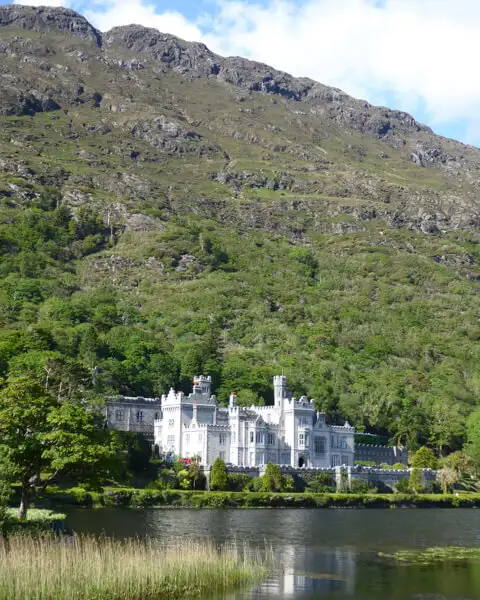
Intro
It is one of the most important sights on the west coast – Kylemore Abbey.
You can hardly find out about Galway or Connemara without coming across it, so it’s not an insider tip, but one of those places that is much talked about and much visited. Especially by coaches.
I don’t like coaches and I don’t like crowds. But I couldn’t help but take at least one look at the much-praised Abbey on my motorbike trip through Connemara and Mayo. I’m too curious for that.
Despite the beautiful summer day, the crowds were pleasantly manageable.
I’m glad I made this decision, because the contrast between this gleaming white castle and the rugged mountains that surround it is simply too beautiful.
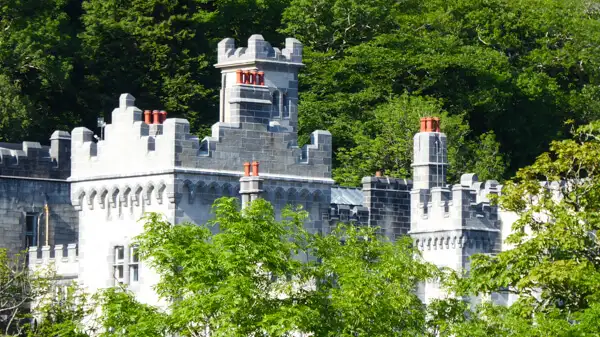
Why is the castle actually a monastery? Doesn’t it look like a monastery at all? We’ll get to that in a moment.
As always in Ireland, if I have nothing else planned, I stay longer than planned and take lots of photos, as I did here.
In short: Connemara is a marvellously beautiful region and Kylemore Abbey is the jewel in the crown.
By the way, we live in Ireland (with a second home). We are originally from Germany. We have travelled the island of Ireland extensively and therefore know it very well.
Werfen wir doch mal einen näheren Blick auf die Geheimnisse der Kylemore Abbey:
Overview of Kylemore Abbey
In 1868, a magnificent castle was built here in the middle of the mountains of Connemara. In Ireland, a castle can be a crumbling square tower, a medieval fortress or a residential castle – here we are talking about a beautiful, prestigious residential castle.
Mitchell Henry, a Doctor from London, bought a former hunting lodge here and spent several years converting it into a castle for his wife Margaret – a very lavish demonstration of love. Mitchell was not only a doctor, but also wealthy, as his family was apparently invested in the profitable textile industry in Manchester.
After the Michells died, the estate was sold to the Duke and Duchess of Manchester in 1903, who only lived here for 11 years but continued to invest in the extension of the building. However, they later had to sell the property again due to gambling debts.
In 1920, Benedictine nuns bought the estate and founded Kylemore Abbey, which is still an abbey, or monastery, today. The nuns came from Belgium, where they lost their monastery to bombing during the First World War and then resettled here in Ireland.
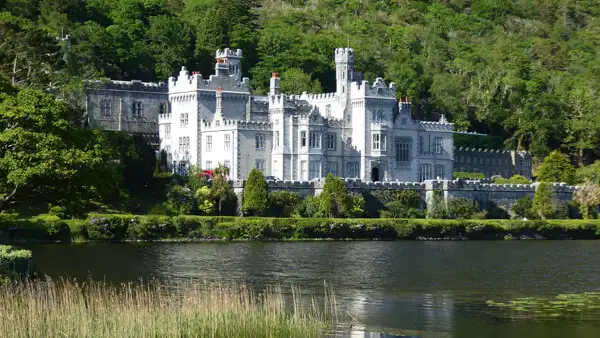
From the very beginning, the nuns managed the estate for agriculture and forestry and nowadays also for tourism, and the Abbey is still an important employer in the region today.
Visiting Kylemore Abbey
When I was at Kylemore Abbey, you could only visit the Victorian Walled Gardens. The house was not open to visitors because it was used as a monastery.
However, a lot seems to have changed since then: You can now take a tour of the building, where you can see several rooms in the style of the period, you can visit the beautiful Neogothic Church, the gardens and there are several small signposted walks in the surrounding area.
If you buy an entrance ticket, it is valid for the whole day and for all the sights inside and outside. So you can enjoy the beautiful Abbey and its marvellous gardens at your leisure. See: https://www.kylemoreabbey.com/.
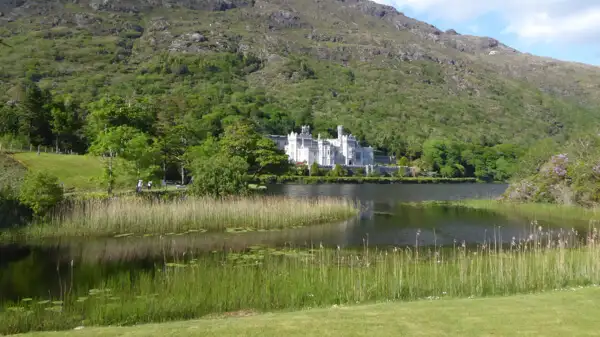
Connemara mountains
Connemara is a region in the west of Galway. A mountainous region in the heart of Connemara forms the Connemara National Park. The visitor centre of the national park is located near Letterfrack, see also: https://www.nationalparks.ie/connemara/.
The mountain landscape is a dream for hikers, but it’s also great to explore the small roads through the mountains by bike, motorbike or car. By the way, when I say mountains, I mean low mountain ranges with mountains around 700 metres in height.
Horse lovers will have heard of the Connemara ponies. Many Connemaras are small horses rather than ponies and are very popular in sport, especially in show jumping, hunting and eventing.
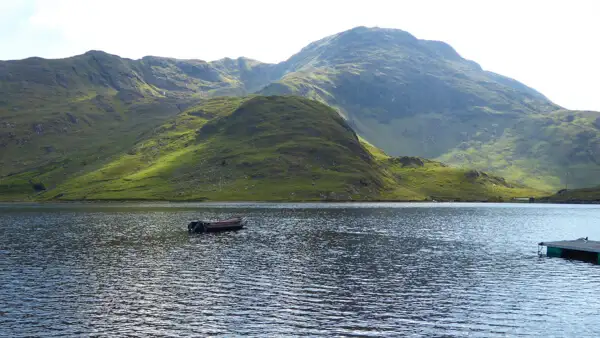
In addition to the sporty Connemara ponies, which have been refined through crossbreeding with Arabians, Berbers and Welsh ponies, there are also stronger breeds with Draught Horses (cold-blooded horses) and smaller, frugal, strong ponies in the Clifden style.
The small town of Clifden is also the most important place in Connemara and the centre of Connemara pony breeding. What all Connemara breeds have in common is that the ponies grow up in a harsh climate on rocky ground with sparse grass and are therefore considered robust and frugal. Like the land, like the ponies!
Incidentally, you are in a region of the Gaeltacht, which are the regions in the west and north-west of Ireland where Irish, the Irish Gaelic language, is still a living language. If you don’t understand people, it might be because they are speaking Irish!
There are many raised bogs in the mountains where peat is still cut by hand. It was dried and transported away to be used as fuel in the open fires and old cottages – a necessity in the mountain world, which is rather poor in forests. Even today, you can still smell the sour odour of peat fires wafting through the streets in many places during the cold season, but this tradition is becoming less and less common.
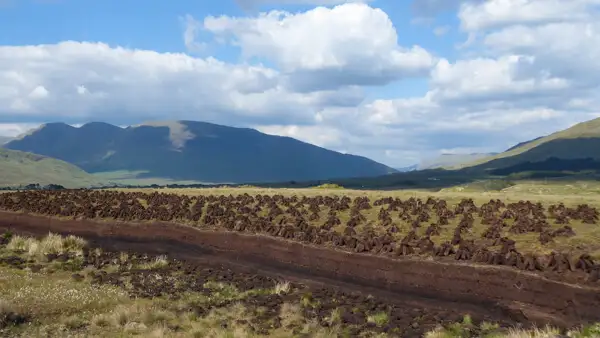
In the mountains you will also find beautiful lakes such as Lough Inagh, Lough Muck and Lough Fee, at least one of which you should visit.
Connemara not only has mountains and upland moors, but also beautiful coastlines with cliffs and beautiful sandy beaches. You will find particularly beautiful stretches of coastline to the south and west of Clifden. You will have to leave the N59 to get to the coast on small roads, but the diversions is definitely worth it!
What else you can do and see in the region
Clifden
The small town of Clifden is very busy in summer, as many travellers use it as an overnight stopover. I can also recommend this, as the pretty little town offers B&Bs as well as pubs, restaurants and shops. From here, you can take a loop along the very scenic Sky Road, which is signposted from the town centre. You will also pass Clifden Castle on the way. This is a ruin from where you have a wonderful view of Clifden Bay.
Lough Inagh
This beautiful lake is located on the R344, which you can easily take as part of a Connemara round trip on the way there or back to Galway. Enjoy the beautiful valley and the view of Lough Inagh. Near the junction with the N59, you will also find the famous Pines Island Viewpoint, a tree-covered island in Derryclare Lough with a wonderful mountain backdrop.
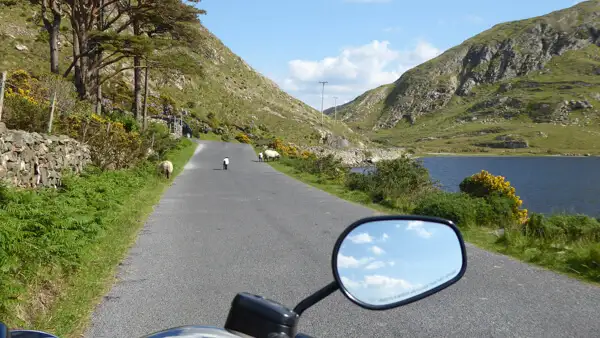
Aughnanure Castle
This is almost an insider tip. The small castle, or its ruins, is located close to the N59 near Oughterard. The car park is very small and not suitable for large numbers of tourists – but Aughnanure Castle is nice to see, with a small exhibition in the residential tower. See: https://heritageireland.ie/places-to-visit/aughnanure-castle/.
Killary Fjord
Killary Fjord is the only real fjord on the island of Ireland and is a scenic gem. It is also known as Killary Harbour because it offers a sheltered, natural harbour. Just follow the N59 northwards and you’ll get there. This is also the border of County Galway and the Connemara region with the Mayo region further north.
Dog’s Bay and other beaches
Dog’s Bay is a beautiful beach near Errisbeg. Other beautiful beaches include Aillebrack Beach near Aillebrack, Omey Beach near Claddaghduff, and Renvyle Beach near Rusheenduff.
Hiking in Connemara
You can do circular walks and day hikes in many places. And then there is also the Western Way Galway, one of over 43 long-distance hiking trails in Ireland, which also leads through the highlands of Connemara. You can find more information in this article I wrote: https://ireland-insider.com/round-trip-in-the-north-of-ireland-with-day-hikes-8-great-ideas-for-you/.
Conclusion
If you are travelling to Galway, I can highly recommend doing at least a day trip through Connemara. But even two days in Connemara is not too much.
And if you are travelling in Connemara, you should also stop by the region’s most important attraction, Kylemore Abbey.
You might also like to visit Aughnanure Castle.
If you then drive the Sky Road at Clifden, or visit one of the beautiful beaches, or look at a few lakes in the mountains, or drive on to Killary Fjord, then you have a nice combination of some sights, the wild and romantic highlands of Connemara and beautiful coasts with beaches and cliffs…
Sounds like a holiday already? Yes, isn’t it?
Have fun in Connemara and at Kylemore Abbey!
More interesting articles for you
DROMBEG STONE CIRCLE – THE MEGALITHIC HERITAGE OF IRELAND
GLENDALOUGH MONASTIC CITY – A MUST-SEE-PLACE IN IRELAND’S ANCIENT EAST!
THE LEGENDARY ROCK OF CASHEL
THE AMAZING KILKENNY CASTLE
Picture credits cover picture: Kylemore Abbey, photo by Ulrich Knüppel-Gertberg (www.irland-insider.de, www.ireland-insider.com)